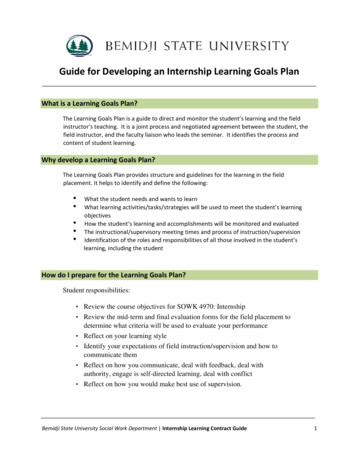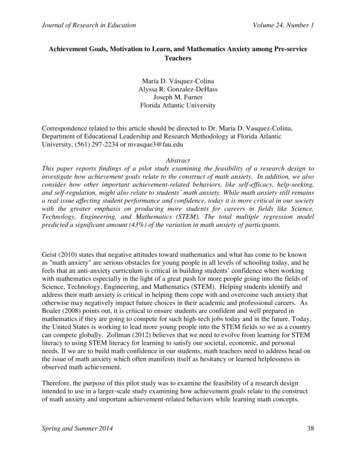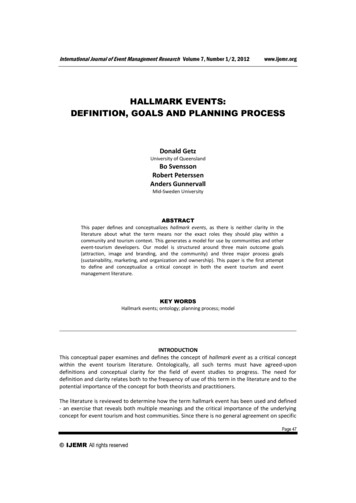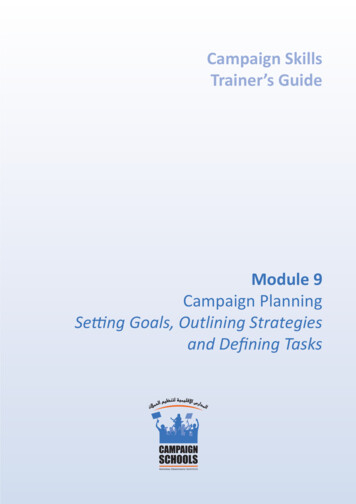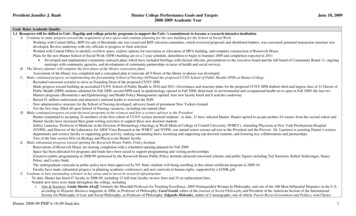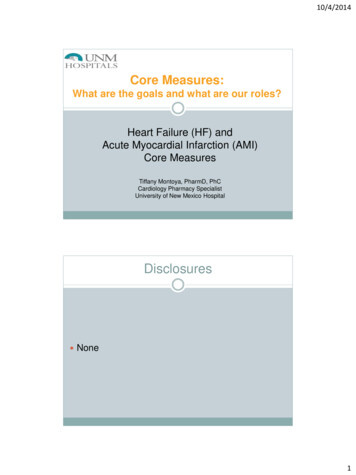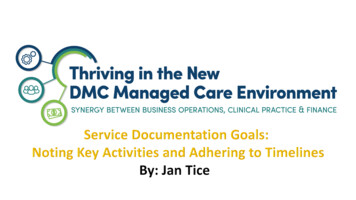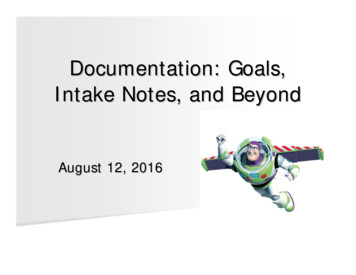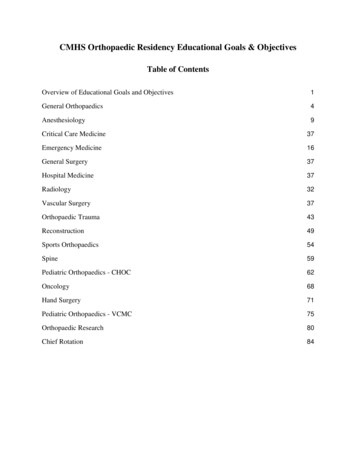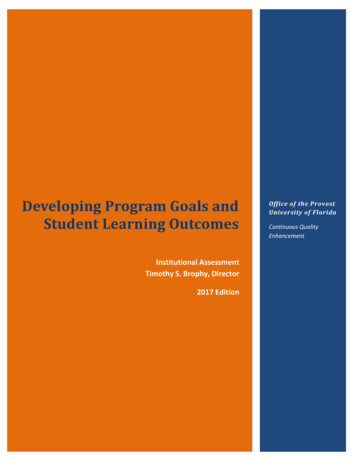
Transcription
Developing Program Goals andStudent Learning OutcomesInstitutional AssessmentTimothy S. Brophy, Director2017 EditionOffice of the ProvostUniversity of FloridaContinuous QualityEnhancement
Continuous Quality Enhancement at the University of FloridaProgram Goals and Student Learning OutcomesTable of ContentsProgram Goals and Student Learning Outcomes . 2Introduction . 2Developing Program Goals . 2Developing S.M.A.R.T. Goals for Academic Programs . 3Specific. 3Measurable . 3Attainable . 3Relevant . 3Time-limited or time-sensitive. 4Goal Format . 4Developing Student Learning Outcomes . 4The Three R’s of SLOs: Recent, Relevant, and Rigorous . 4Outputs and Outcomes: What is the difference?. 4Components of Effective Student Learning Outcomes . 5Recommended Steps for Developing and Revising Student Learning Outcomes . 6Submitting Revised SLOs for approval . 6Support. 6Table 1. The Knowledge Dimension – Bloom’s Revised Taxonomy . 7Table 2. The Cognitive Process Dimension – Bloom’s Revised Taxonomy. 8Table 3. Verbs for Bloom’s Taxonomy . 10Figure 1. The Taxonomy Table . 11Works Cited . 121Institutional Assessment – University of Florida Office of the ProvostDeveloping Program Goals and Student Learning Outcomes
Continuous Quality Enhancement at the University of FloridaProgram Goals and Student Learning OutcomesIntroductionBecause teaching is a primary mission of the University of Florida (UF), evidence of studentlearning is a measure of our success as an educational institution. Regional accrediting agenciesacross the United States require that universities provide evidence of student learning and programimprovement to demonstrate their effectiveness as educational institutions1. Student LearningOutcomes (SLOs) specify what students will know and be able to do as a result of completing theirdegree programs. Program Goals (PGs) are broad statements of what the program intends toaccomplish. Program Goals and Student Learning Outcomes (a) are consistent with the mission ofthe university, college, and department, and (b) align with the values of the faculty.Program Goals and Student Learning Outcomes serve to describe how the program mission isoperationalized. Each academic program has a mission, and the SLOs and PGs form a blueprint ofhow the key principles of the program mission are met.SLOs and PGs are reviewed annually and revised periodically in response to faculty review ofoutcome and goal data. This document provides guidelines for developing goals and outcomes foracademic programs.Developing Program GoalsProgram goals include the broad educational goals of the program (i.e., to graduate students whoare prepared for the workplace) and programmatic elements such as, but not limited to, thefollowing: Total number of students enrolled Percent minority students Percent of admits from those who applied Percent matriculated from those admitted Median time to degree Percent attrition rate Percent completion rate Number of graduates Number of graduates produced per budgeted faculty positionGoals are measured by establishing specific actions that will provide data that inform the faculty ofthe progress they are making toward achieving the goal.The Southern Association of Colleges and Schools Commission on Colleges (SACSCOC) Comprehensive Standard 3.3.1.1requires that all programs identify “expected outcomes, assesses the extent to which it achieves these outcomes, andprovides evidence of improvement based on the analysis of the results in each of the following areas: education programs,to include student learning outcomes” (Southern Association of Colleges and Schools Commission on Colleges(SACSCOC), 2015, pp. 48-51)12Institutional Assessment – University of Florida Office of the ProvostDeveloping Program Goals and Student Learning Outcomes
Continuous Quality Enhancement at the University of FloridaDeveloping S.M.A.R.T. Goals for Academic ProgramsS.M.A.R.T goals are specific, measurable, attainable, relevant, and time-limited or time-sensitive.This model for goal development can be helpful when developing academic program goals. Hereare the basic components of S.M.A.R.T goals and guiding questions for developing them.Specific What do we want to accomplish? Why: Specific reasons, purpose or benefits of accomplishing the goal Who: Who is involved? Which: Identify requirements (essential attributes) and constraintsMeasurable Need to establish concrete criteria for measuring progress toward the attainment of thegoal Measurable goals use active verbs to describe specific expectations Measuring progress helps you to stay on track, reach target dates, and experience thesuccess of achievement Guiding questions: How much are we looking for? How many are we seeking? How will Iknow when it is accomplished?Attainable Goals must be realistic and attainable Attainable goals may stretch a team in order to achieve it, the goal is not extreme Goals are neither out of reach nor below standard performance, as these may be consideredmeaningless When you identify goals that are most important to you, you begin to figure out ways youcan make them come true. You develop the attitudes, abilities, skills, and financial capacityto reach them According to theory, an attainable goal may cause goal-setters to identify previouslyoverlooked opportunities to bring themselves closer to the achievement of their goals. Guiding questions: How can the goal be accomplished? Does the goal represent an objectivetoward which you are both willing and able to work? Is the goal both high and realistic?Does the goal represent substantial progress?Relevant Choose goals that matter. Many times you will need support to accomplish a goal: resources, a champion voice,someone to knock down obstacles. Goals that are relevant to your leadership, your division or college, and yourorganization will receive that needed support. Relevant goals (when met) drive the, department, division, and organization forward A goal that supports or is in alignment with other goals would be considered a relevant goal Relevant goalso Are worthwhileo Are set at the right timeo Match other efforts/needso Are assigned to the right person/area/groupo Can be modified as needed3Institutional Assessment – University of Florida Office of the ProvostDeveloping Program Goals and Student Learning Outcomes
Continuous Quality Enhancement at the University of FloridaTime-limited or time-sensitive Goals must be grounded within a time frame, giving them a target date A commitment to a deadline helps a team focus their efforts on completion of the goal on or before the due date This part of the S.M.A.R.T. goal criteria is intended to prevent goals from beingovertaken by the day-to-day crises that invariably arise in the academy Tips for designing time-limits:o Provide a timeframe for the completion of the goalo Describe what can be done in 6 months, 6 weeks, or todayo Set a sequence of activities that will serve as benchmarks for achieving the goalGoal FormatGoal statements are usually structured as follows:“To (action verb) (object) (modifiers).”Some examples of educational program goals: “To graduate students who are prepared to be independent researchers.” “To adequately prepare students for graduate school.”Some examples of program goals that are not related to student learning: “To increase the number of our degree-seeking students by 10% in 2015-16.” “To hire two new faculty members in our program.”Developing Student Learning OutcomesThe Three R’s of SLOs: Recent, Relevant, and RigorousStudent Learning Outcomes reflect the curriculum, and as curriculum evolves, learning outcomeschange. SLOs should be recent, relevant, and rigorous. Recent outcomes reflect current knowledgeand practice in the discipline. Relevant outcomes relate logically and significantly to the discipline.Rigorous outcomes require an appropriate degree of academic precision and thoroughness to bemet successfully.Outputs and Outcomes: What is the difference?Outputs describe and count what we do and whom we reach and represent products or serviceswe produce. Processes deliver outputs; what is produced at the end of a process is an output. Forexample, in a PhD student recruitment process the output might be 10 new PhD students. At theend of a degree program, the output might be a certain number of graduates.An outcome is a level of performance or achievement. It may be associated with a process or itsoutput. Outcomes imply measurement - quantification - of performance. Here are two examples:1. Students analyze experimental data and interpret results in the cellular and molecularsciences.2. Students discriminate musical quality based on sound musical reasoning.These outcomes describe student learning that is observable and measureable throughassessment.4Institutional Assessment – University of Florida Office of the ProvostDeveloping Program Goals and Student Learning Outcomes
Continuous Quality Enhancement at the University of FloridaThis distinction is important, especially in the development and review of Student LearningOutcomes. We seek to measure outcomes as well as their associated outputs; however, SLOsfocus on outcomes. For example, while we produce a number of new graduates (the output),it is important to have a measure of the quality of the graduates as defined by the college ordiscipline (the outcome). Effective Student Learning Outcomes describe, in measurableterms, these quality characteristics by defining our expectations for knowledge, criticalthinking, and communication for UF graduates.Components of Effective Student Learning OutcomesEffective SLOs:1. Focus on what students will know and be able to do. All disciplines have a body ofcore knowledge that students must learn to be successful as well as a core set ofapplications of that knowledge in professional settings. Effective knowledge SLOsbegin with phrases such as “Students describe .”, “Students identify ” or similarverbs that specify a behavior that indicates knowledge acquisition.When writing SLOs that focus on what students are able to do as a result of theprogram, select a verb that best describes the action involved in the observedbehavior. A guiding question is: what cognitive processes or skills do studentsengage when demonstrating the behavior? For example, “Students analyze ”,“Students evaluate ” or similar verbs that specifically describe the behaviorexpected (see Table 3 for a more thorough list of verbs associated with Bloom’sTaxonomy).2. Describe observable and measureable actions or behaviors. Effective SLOs present acore set of observable, measureable behaviors. Measurement tools vary fromquizzes and tests to complex rubrics. There are some verbs to be avoided whenwriting SLOs, because they designate behaviors that are internal and not observable.Here is a list of verbs and phrases to avoid: UnderstandAppreciateBecome familiar withLearn about, think aboutBecome aware of , gain an awareness ofDemonstrate the ability toBloom’s Taxonomy (Anderson, et al., 2001) is a widely accepted description of thedimensions of knowledge and cognitive skills that are used to formulate educationalobjectives. Student Learning Outcomes are the educational objectives of UF degreeprograms, so this taxonomy provides a valuable resource in developing measureable SLOs.Table 1 presents the Knowledge dimension levels and their descriptions. Table 2 presentsthe Cognitive dimension and the six levels of the hierarchy and their descriptions. Table 3presents a list of specific verbs that engage students in processes that are observable andmeasurable.5Institutional Assessment – University of Florida Office of the ProvostDeveloping Program Goals and Student Learning Outcomes
Continuous Quality Enhancement at the University of FloridaRecommended Steps for Developing and Revising Student Learning Outcomes1. Review the current SLOs for your area with your program faculty.2. Examine the SLOs for the Knowledge Type (see Table 1) and Cognitive Processes level (seeTable 2) they engage. The majority of the SLOs should be in the upper three levels of theCognitive Processes Dimension – Analyze, Evaluate, and Create. The Taxonomy template inFigure 1 may help with this process.3. Cross-reference your SLOs with the list of verbs/actions associated with theircorresponding cognitive dimension levels (see Table 3), and replace any “verbs and phrasesto avoid” (see the above list) with appropriate verbs from Table 3.4. Write the SLO concisely and clearly.Submitting Revised SLOs for approvalAny major changes of content or intent in an SLO must go through the AAP/ALC formal revisionprocess.If the SLO revision process results in the re-wording of a current SLO and does not change theintent or meaning of the SLO, the SLO can be edited directly in the AAP, and does not need to bereviewed and reapproved by the Academic Assessment Committee.SupportInstitutional Assessment staff members are available for assistance with training on how todevelop/revise Program Goals and Student Learning Outcomes. Please contact Cheryl Gater atcgater@aa.ufl.edu or 392-4208, or Tim Brophy, tbrophy@aa.ufl.edu, or 273-4476.6Institutional Assessment – University of Florida Office of the ProvostDeveloping Program Goals and Student Learning Outcomes
Continuous Quality Enhancement at the University of FloridaTable 1. The Knowledge Dimension – Bloom’s Revised TaxonomyMajor Types and SubtypesExamplesA. Factual Knowledge – The basic elements students must know to be acquainted with a disciplineor solve problems in itAA. Knowledge of terminologyTechnical vocabulary, music symbolsAB. Knowledge of specific details andMajor natural resources, reliable sources ofelementsinformationB. Conceptual Knowledge – The interrelationships among the basic elements within a largerstructure that enable them to function togetherBA. Knowledge of classifications andPeriods of geological time, forms of businesscategoriesownershipBB. Knowledge of principles andPythagorean theorem, law of supply and demandgeneralizationsBC. Knowledge of theories, models, andTheory of evolution, structure of CongressstructuresC. Procedural Knowledge – How to do something, methods of inquiry, and criteria for using skills,algorithms, techniques, and methodsCA. Knowledge of subject-specific skills and Skills used in painting with water colors, wholealgorithmsnumber division algorithmCB. Knowledge of subject-specificInterviewing techniques, scientific methodtechniques and methodsCC. Knowledge of criteria for determiningCriteria used to determine when to apply awhen to use appropriate proceduresprocedure involving Newton’s second law, criteriaused to judge the feasibility of using a particularmethod to estimate business costsD. Metacognitive Knowledge – Knowledge of cognition in general as well as awareness andknowledge of one’s own cognitionDA. Strategic knowledgeKnowledge of outlining as a means of capturing thestructure of a unit of subject matter in a textbook,knowledge of the use of heuristicsDB. Knowledge about cognitive tasks,Knowledge of the types of tests particular teachersincluding appropriate contextual andadminister, knowledge of the cognitive demands ofconditional knowledgedifferent tasksDC. Self-knowledgeKnowledge that critiquing essays is a personalstrength, whereas writing essays is a personalweakness; awareness of one’s own knowledge levelFrom: Anderson, Krathwohl, Airasian, Cruikshank, Mayer, & Pintrich, 2001.7Institutional Assessment – University of Florida Office of the ProvostDeveloping Program Goals and Student Learning Outcomes
Continuous Quality Enhancement at the University of FloridaTable 2. The Cognitive Process Dimension – Bloom’s Revised TaxonomyCategories &Cognitive ProcessesAlternativeNamesDefinitions and Examples1. Remember – Retrieve relevant knowledge from long-term memory1.1 RecognitionIdentifyingLocating knowledge in long-term memory that isconsistent with presented material (e.g., Recognizethe dates of important events in U.S. history)1.2 RecallingRetrievingRetrieving relevant knowledge from long-termmemory (e.g., Recall the dates of important events inU.S. history)2. Understand – Construct meaning from instructional messages, including oral, written, andgraphic communication2.1 InterpretingClarifying,Changing from one form of representation (e.g.,paraphrasing,numerical) to another (e.g., verbal) (e.g., Paraphraserepresenting,important speeches and documents)translating2.2 ExemplifyingIllustrating,Finding a specific example or illustration of a conceptinstantiatingor principle (e.g., Give examples of various artisticpainting styles)2.3 ClassifyingCategorizing,Determining that something belongs to a categorysubsuming(e.g., concept or principle) (e.g., Classify observed ordescribed cases of mental disorders)2.4 SummarizingAbstracting,Abstracting a general theme or major point(s) (e.g.,generalizingWrite a short summary of the events portrayed on avideotape)2.5 InferringConcluding,Drawing a logical conclusion from presentedextrapolating,information (e.g., In learning a foreign language, inferinterpolating,grammatical principles from examples)predicting2.6 ComparingContrasting,Detecting correspondences between two ideas,mapping,object, and the like (e.g., Compare historical events tomatchingcontemporary situations)2.7 ExplainingConstruc
Developing Program Goals and Student Learning Outcomes. Recommended Steps for Developing and Revising Student Learning Outcomes . 1. Review the current SLOs for your area with your program faculty. 2. Examine the SLOs for the Knowledge Type (see Table 1)
